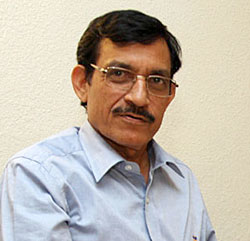INDIAN ARMED FORCES CHIEFS ON
OUR RELENTLESS AND FOCUSED PUBLISHING EFFORTS

SP Guide Publications puts forth a well compiled articulation of issues, pursuits and accomplishments of the Indian Army, over the years

I am confident that SP Guide Publications would continue to inform, inspire and influence.

My compliments to SP Guide Publications for informative and credible reportage on contemporary aerospace issues over the past six decades.
- Prime Minister witnesses 'Bharat Shakti' – a Tri-Services Firing and Manoeuvre Exercise in Pokhran, Rajasthan
- Interim Defence Budget 2024-25 — An Analysis
- Union Defence budget 2024
- Prime Minister Modi Commemorates Indian Navy Day in a Grand Ceremony
- Prime Minister Modi Flies in the LCA Tejas
- New Chapter in India-Italy Defence Ties
- Airpower beyond Boundaries
Sacking of DRDO Chief — Is it a sign?
 |
By Lt. General P.C. Katoch (Retd) Former Director General of Information Systems, Indian Army |
Sacking of Avinash Chander, the DRDO Chief 16 months prior to completion of his tenure has made headlines. Is it a warning shot for the organization to get the ball rolling and usher in some accountability? Most countries do not have the type of DRDO complex: over 50 laboratories, 9 DPSUs and 42 Ordnance Factories - overall manpower of I,80,044 employees. Now a CCS note requests expand to take control of commercialization of defence equipment. The 1995 Review Committee under Dr (later President) Abdul Kalam set the target of 70% in defence equipment by 2014 but no progress has been made after 19 years.

Sowhere is the accountability? Isn’t it shocking that our Ministry of Commerce and Industry website states 50% defence equipment currently held by our military is obsolete, production of state-of-the-art equipment needs to grow from 15% to 30%, and current cycle including acquisitions under the LTIPP would require procurements worth US$ 100 billion by 2022. Going by last few CAG reports: DRDO has been developing substandard equipment or with extended deadlines and additional budgets; many projects are without MoD approval including just 10% by one report; corruption and nepotism exists in the upper echelons; in 2010, a modular bridge being developed for army was shelved after 8 years and spending Rs 21.46 crore but just six months later another Rs 13.25 crores was sanctioned for another modular bridge project; in 2011-2012, crores have been spent on random research and of 55 high priority projects based on user-requirements, only 13 had gone into production; and the initiative to produce next generation laser weapons was shut down within a month after equipment for research was procured. These are but few examples. CGDA audit has been equally revealing: DRDO has been buying equipment from other companies ‘after’ spending crores on R&D. For example, after spending five years and 129.96 crores to develop satellite signal monitoring equipment, DRDO ultimately bought the same from a PSU on single tender basis for 724.50 crores in April 2011; when COTS equipment is available, DRDO still spends crores of rupees for reinventing the wheel. For example, DRDO spent Rs 6.85 crores to develop explosive detectors, which were then offered to the army for Rs 30 lakh per piece while COTS versions were available at Rs 9.8 lakh apiece and that too with repair and maintenance; through JVs with foreign firms, older technology is being imported without mandatory ToT agreement. The report submitted by the Parliamentary Standing Committee on Defence to the Parliament on 22 December 2014 has brought out amongst other things that the DRDO, tasked with developing technology for the military, has failed since 1982 to produce an acceptable INSAS rifle, the standard weapon of the army. What may not be known that the DRDO had been provided 17 x 5.56 top assault rifles of 11 countries in 1982 to develop the INSAS and yet the INSAS is nowhere close to the top ten in its category despite 15 years of development. Despite importing all IR tubes, Indigenous night vision equipment continues to be heavy and bulky. The Tejas Mk I is coming 30 years after the LCA project was sanctioned. Why we should have continuous ammunition shortages is another story. In his first address to the DRDO, Prime Minister Modi had stressed the need for scientists to complete work in time, and stay ahead of technological innovations. But if we have major voids in modern technology and modernization of our armed forces, the reasons are: DRDO emphasis is less on R&D and more on commercialization to earn profit; glaring voids in accountability, focused roadmap and periodic reviews, and; resistance to users (military) being posted at design, planning and decision making levels because of rampant corruption. Sacking of DRDO Chief may just be a warning to others and stop the “Chalta Hai” attitude but what is needed is a complete revamp: rename DRDO as ‘Avishkar Udyog’ and charge it exclusively for R&D, not commercialization; commercialization of defence equipment should be pursued through military-civil-industrial zones, with DRDO affiliated to it; users (military professionals be posted at design, planning and decision making levels pan the defence-industrial complex.





